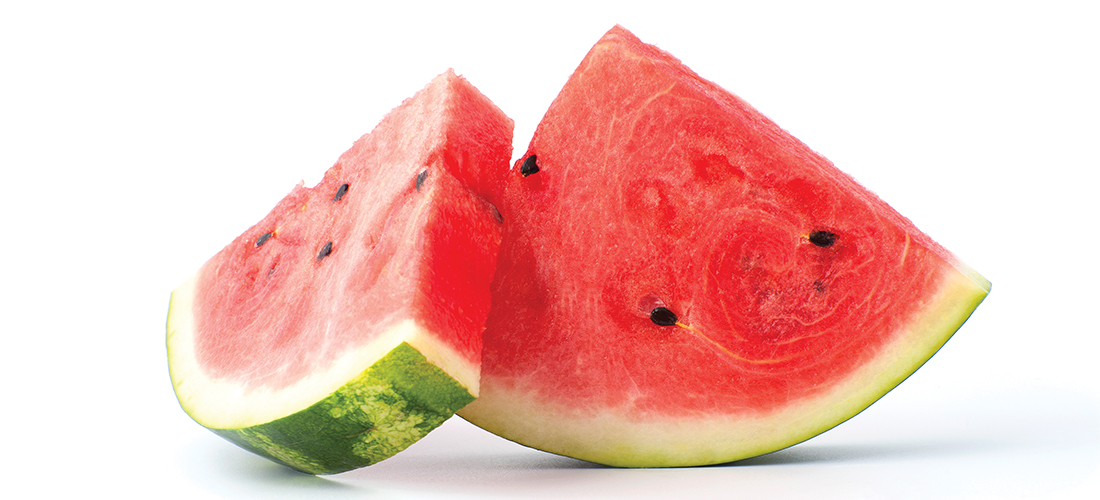
Watermelon makes cool, refreshing memories
By Jan Leitschuh
August boasts an abundance of produce, but it’s also a time of change. The blasting heat usually causes a decline in some produce while bringing others forward. Early August offers up outstanding freestone peaches, cantaloupe, sweet bell peppers, honeydew melons, heirloom tomatoes, the very last of summer’s blueberries, and watermelon in the markets and local gardens, before easing into okra, eggplant, cherry tomatoes, field peas, muscadines and more peaches late in the month.
This means it’s often your last chance to grab a really fine, peak-season summer watermelon. If you love watermelon but have been avoiding the hefty fruit because “it’s just too much,” and you lack refrigerator space, then this word salad is for you.
The South is known for its really fine melons, and Sandhills melons are the apex. The light sandy soil lets vine-producing nitrogen slip on through, while retaining more of the minerals that encourage sweet fruits. The result, say some of our local farmers, is that produce buyers from other states seek them out. Watermelon is the most-consumed melon in the United States.
Memories have been made around the massive red fruits. Before air-conditioning — that culture-changing innovation that swept folks off their porches and into the interior of their houses — an iced melon was a genuine refreshment, and a worthy excuse for social lollygagging. Perhaps this is a practice worthy of reinvention?
Watermelons are, in essence, a social fruit. They come in big, unwieldy packages and need refrigeration after cutting. To be fully eaten, they need to be shared.
My husband, a Charlotte native, recalls his Uncle Sam bringing over a chilled watermelon on sunny summer Sundays. Chances were, he grew it in his own large truck garden. Three generations of Millers would gather in the backyard as Sam split the melon into juicy, seedy slices. A saltshaker appeared on the old yard table.
The grownups would sit around under the shade tree, telling family stories, rocking on those old 1950s metal chairs with the tubular loops that glided back and forth. Grandma Miller would air herself with an old church bulletin, while the young’uns would run around spitting black seeds at each other. The occasional bee would buzz, sipping at the rinds the kids chucked into the neighboring field.
Later, these same children would grow up and gather with their peers, injecting alcoholic adulterants like rum or vodka into their melons.
In an era even earlier, say, Grandma Miller’s younger days, food was unpredictable enough that nothing was wasted. Even the watermelon rinds were preserved for future use, converted into food treats such as watermelon rind candy, pickled watermelon rind, watermelon rind chutney and more. My mom, a Wisconsin gal who loved the South, made them to be consumed with pork in the fall or put on a little crystal dish at Thanksgiving. I’ve only heard of one millennial who has ever tried this, and she learned from a grandmother of the South.
Change is constant, and things are different. Today, the old recipes live on, but their electronic info is stashed on the internet rather than inside a granny-woman’s head. We live less gregarious lives, tucked in our air-conditioned houses on hot days. Farmers grow smaller “icebox” sized melons, easier to consume. Grocery stores offer servings, useful pre-wrapped watermelon slices, or even pre-chunked into handy plastic containers.
Chefs do clever things with melon, carving them up, or making culinary creations that go well beyond simple slicing, salting and eating. A quick search of online recipes reveals, in the first score of offerings, instructions for making: watermelon ice pops (for the kids) and sorbets or sherbets (for all); watermelon gazpacho; watermelon cake; watermelon jellies; watermelon salsa; watermelon agua fresca; watermelon and strawberry lemonade; minted watermelon and cucumber salad — which seemed weird at first, but upon reflection actually makes sense, as the ingredients are juicy, cool and refreshing; and tomato, watermelon and feta skewers.
Something sweet and light has to be a nutritional lightweight, right? I was surprised to learn that watermelon has more lycopene than tomatoes. Lycopene is a powerful antioxidant, and it also gives watermelon its pink-red color. It’s a splendid source of vitamin C, which strengthens immunity, heals wounds, prevents cell damage and promotes healthy teeth and gums. It also provides vitamin B6, which helps brain function and to convert protein to energy.
Watermelons come in a wide array of sizes with flesh that can be red, pink, yellow or orange. The popular “seedless” varieties contain a few white seeds that are small, soft and edible. By weight, watermelons are 92 percent water — no wonder they’re so hydrating and refreshing!
Tap a ripe melon and you’ll hear a hollow thump. The rind should be smooth, round and unblemished, with a yellow spot on one side where the melon sat on the ground, ripening in the sun. Once cut, store melons in the fridge. Cover slices with plastic, or deconstruct into chunks and cover.
If you need to consume watermelon quickly to free up fridge space, consider using it as a base for healthy, hydrating smoothies, chilled fruit soups or summer drinks. You can freeze leftover drinks for a sort of sorbet treat, or a watermelon ice.
Icy Watermelon Cooler
8 cups (1/2-inch) watermelon cubes
1/3 cup water
1 (6-oz.) can frozen limeade concentrate
(Adult option: rum or vodka)
Preparation
Place watermelon cubes in a single layer in an extra-large zip-top plastic freezer bag and freeze eight hours. Remove and let stand at room temperature fifteen minutes.
Process half each of watermelon, water and limeade concentrate in a blender until smooth; pour mixture into a pitcher. Repeat procedure with remaining half of ingredients; stir into pitcher, and serve immediately.
Watermelon Rind Preserves
6 cups watermelon rind, diced
4 1/2 cups sugar
1 lemon, sliced thinly, then seeded
1 tsp. allspice (optional)
Preparation
Peel green skin off the watermelon, but leave a little of the red pulp on rind. Cut into one-inch slices, then slice into one-inch cubes. Place rind in a large pot and cover with the sugar until the fruit doesn’t show. Cover with plastic wrap; refrigerate overnight.
Place pot on stove and add lemon slices and allspice, if desired. Boil whole mixture until rind is clear, about two hours.
Pack into clean, hot jars. Wipe rims and screw on lids. Process ten minutes in boiling water deep enough to cover lids by at least one inch. Serve the preserves on buttered toast, if desired.
NOTE: After cutting watermelon, save the rind in the refrigerator until you are ready to prepare the preserves. PS
Jan Leitschuh is a local gardener, avid eater of fresh produce and co-founder of the Sandhills Farm to Table Cooperative.





